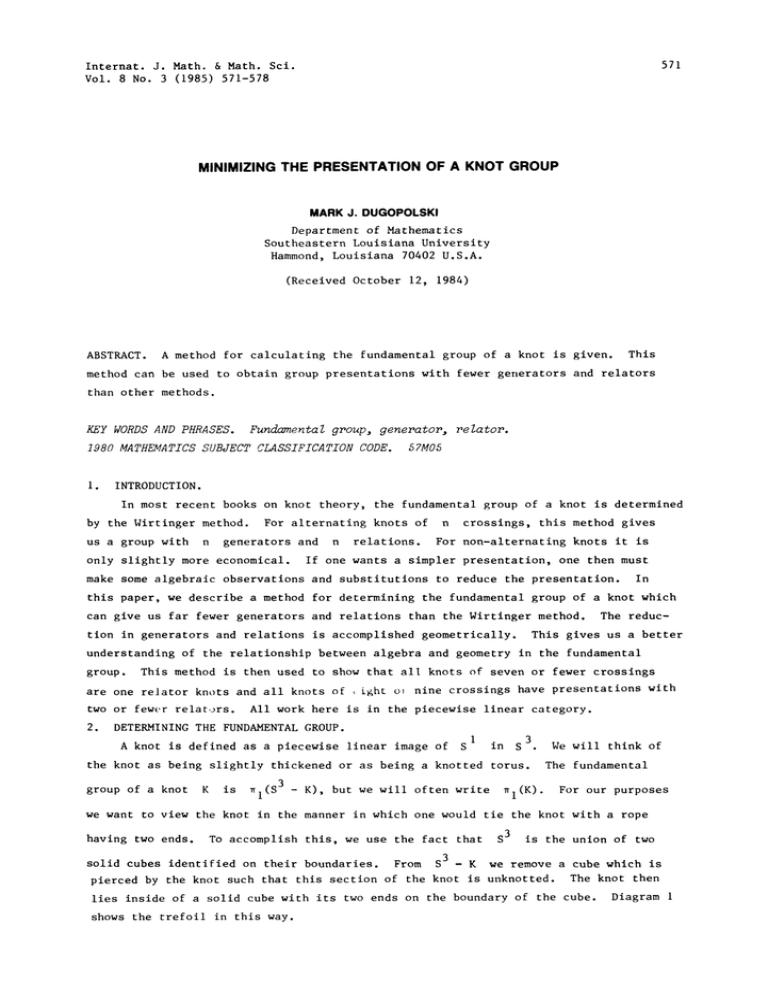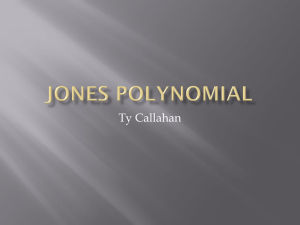PRESENTATION OF A KNOT GROUP MINIMIZING THE
advertisement

571
Internat. J. Math. & Math. Sci.
Vol. 8 No. 3 (1985) 571-578
MINIMIZING THE PRESENTATION OF A KNOT GROUP
MARK J. DUGOPOLSKI
Department of Mathematics
Southeastern Louisiana University
Hammond, Louisiana 70402 U.S.A.
(Received October 12, 1984)
ABSTRACT.
A method for calculating the fundamental group of a knot is given.
This
method can be used to obtain group presentations with fewer generators and relators
than other methods.
Fundamental group, generator, relator.
1980 MATHEMATICS SUBJECT CLASSIFICATION CODE. 57M05
KEY WORDS AND PHRASES.
I.
INTRODUCTION.
In most recent books on knot theory, the fundamental group of a knot is determined
by the Wirtinger method.
us a group with
n
For alternating knots of
generators and
only slightly more economical.
n
relations.
n
crossings, this method gives
For non-alternating knots it is
If one wants a simpler presentation, one then must
make some algebraic observations and substitutions to reduce the presentation.
In
this paper, we describe a method for determining the fundamental group of a knot which
can give us far fewer generators and relations than the Wirtinger method.
The reduc-
This gives us a better
tion in generators and relations is accomplished geometrically.
understanding of the relationship between algebra and geometry in the fundamental
This method is then used to show that all knots of seven or fewer crossings
are one relator knots and all knots of ight oi nine crossings have presentations with
group.
two or fewer relators.
2.
All work here is in the piecewise linear category.
DETERMINING THE FUNDAMENTAL GROUP.
A knot is defined as a piecewise linear image of S
in
S
3
the knot as being slightly thickened or as being a knotted torus.
group of a knot
K
is
I(S
3
K), but
we will often write
I(K).
We will think of
The fundamental
For our purposes
we want to view the knot in the manner in which one would tie the knot with a rope
having two ends.
To accomplish this, we use the fact that
S3
is the union of two
3
solid cubes identified on their boundaries. From S
K we remove a cube which is
pierced by the knot such that this section of the knot is unknotted. The knot then
lies inside of a solid cube with its two ends on the boundary of the cube.
shows the trefoil in this way.
Diagram
572
M. J. DUGOPOLSKI
D_iagram..1
We now need to see that
I(S
3
K)
is the same as the
solid cube with the knot drilled out of it.
theorem as stated by Rolfsen [I]:
If
X
X
u X
2
and X
n X
2
X0,
the generators and relations from
for each generator of
I(X2)
I(X0)
fundamental group of the
This is easily seen using Van
then to obtain
I(XI)
and
I(X)
1(X2)
Kampen’s
one throws together
plus one relation
which says that its image in
I(XI)
and
are equal.
To determine
I(K)
we start with a projection of
K
just as in the Wirtinger
method.
We remove a cube at an undercrossing which lies adjacent to an
overcrossing.
We look at a projection of the knot onto the bottom of the
cube, but keep the knot
just slightly above the bottom plane, except at the ends
which are attached to that
plane. See Diagram 2 for an example using the knot
of Rolfsen’s table [I].
41
Diagram 2
Now at each overcrossing we drill
out a hole coming up from the
bottom plane and
then back down as in Diagram 3.
If we ignore the knot,
of
a
cube
with three un71
573
MINIMIZING THE PRESENTATION OF A KNOT GROUP
Diagram 3
knotted holes drilled out is free on three generators,
{a,b,c}.
The disks shown in
Diagram 3 are thought of as the generators and the arrows shown by the disks are for
orientation.
A loop in this space determines a word in the free group according to
which disks it passes through and in which direction, i.e.,
-I
and b
b
is with the arrow
is against the arrow.
Now, since
we separated the knot at an undercrossing which was adjacent to an
overcrossing, there is a direction in which we can traverse this knot which starts
with an overcrossing.
Take the drilled out hole corresponding to this overcrossing
and deform the cube with holes by pushing that first hole around the path of the knot,
just as if we were tying the knot.
See Diagrsm 4.
Diagram 4
The fundamental group of the cube with holes is unchanged by this deformation,
it is still the free group. We now fill in all of the holes except the one forming
the knot. By Van Kampen’s theorem, each hole we fill in introduces a relation into
the free group.
In our example
we fill in
b
and
c
giving us a group with three
generators and two relations as the fundamental group of the knot
method would have given four generators and four relations.
method to see that
3.
41
41
The Wirtinger
Later, we will modify our
is a one-relator knot.
DETERMINING THE RELATIONS.
To determine precisely what the relations are, we must keep track of how the disks
When a pushes through
under holes are deformed. We do this now for the knot
41
M. J. DUGOPOLSKI
574
b
b
must be deformed so that
keep stretching
b
so that
b
a
always stays out in front of
See Diagram 5.
b
does not actually pierce
a
as
a
We
moves over the
rest of the knot.
Diagram 5
on the
To keep track of these disks, we draw a diagram of what is taking place
diaThis
6.
Diagram
See
bttom plane, using arrows to account for the orientations.
in c we get the
gram then tracks across c as shown in Diagram 7. When we fill
b-labc
relation
determined by the meridian shown in Diagram 7.
we can think of pushing
see that
c -l
c -I
goes under
b-lab.
after this instead of
under
a
c
and finally over
Since
b-lab
Now, from Diagram 4, we
b
We get the picture
Diagram
Diagram 7
shown in Diagram 8 and the relation
the knot is
{a,b,c; b-lab
c
c-la-lc-lacb
-l, c-la-lc-lac
I.
b-l}.
Thus the fundamental group of
c -I
MINIMIZING THE PRESENTATION OF A KNOT GROUP
575
Diagram 8
We can perform the process just described on any knot.
knot with
If it is an alternating
crossings, we eliminate one crossing to get it inside the cube, drill
n
holes at the remaining
crossings, then fill in
n
n
2
holes for relations.
This proves the following theorem.
THEOREM I.
tation with
The fundamental group of every
generators and
n
n
2
crossing alternating knot has a presen-
n
relations.
The trefoil knot has a presentation with two generators and one relation and there
is no presentation with fewer generators or relations for the trefoil.
We conjecture
that the trefoil is the only alternating knot for which the number of generators and
relations guaranteed by Theorem
cannot be reduced.
A nonalternating knot has either two consecutive undercrossings or two consecutive
overcrossings. We can assume there are two consecutive overcrossings. Then, in determining I
we drill our hole over more than one segment of the knot, reducing the
number of generators and relations by one each.
THEOREM 2.
presentation with
4.
We may conclude the following theorem.
The fundamental group of any nonalternating knot of
n
2
generators and
n
3
n
crossings has a
relations.
MINIMIZING THE PRESENTATION.
For most knots we can find presentations with far fewer generators and relations
than the numbers guaranteed by Theorems
and 2.
As we described earlier, each hole
drilled up from the bottom plane of the projection determines a relator and we need to
drill holes until the fundamental group of the block is free.
We now look at the knot
41
again, but this time we drill only one hole parallel
to the knot as shown in Diagram 9.
D i a_a__m.__9
576
M .J. DUGOPOLSKI
We then deform the block by sliding the knot over the hole to
get the situation
shown in Diagram I0.
Diagram I0
Further
i. formations as shown i Diagram
that the group is now free.
II unravel the
two
h,|es
and show us
Notice theft to unravel the holes, we repeatedly slide
one end of one hole out from under the other hole.
Thus the knot 4
is a one-relator
In order to see what the relation is, we reverse the steps of Diagram 11,
a and b are deformed in the process. We then slide
knot.
keeping track of how the disks
b
over
a
to get the relation
b-laba-lb-lab -I a-
b
a
-I
Diagram 11
Instead of drilling a hole alongside of the knot and then sliding the knot over
the hole, we can accomplish the same thing by breaking the knot at an undercrossing
and keeping the ends on the bottom plane of the cube.
Thus, if we start with a knot
projection and breaking it at two undercrossings causes the knot to unravel, then the
knot is a one-relator knot.
We must keep in mind that the unraveling is a deformatiom
of the cube wth holes and we can on]v slide an end of the knot out from under another
segment of the knot.
Diagram 12 shows that the knot 7
6
i a one-relator knot.
The above method shows that in general a knot which unravels because of
n
breaks at undercrossings has a presentation with n generators and n
relations.
It is a simple matter to go through a knot table to establish the following theorem.
THEOREM 3. All prime knots which have ,rojections of seven or fewer crossings are
one-relator knots.
All prime knots which have proections with eight or
ings have presentations with two or fewer relations.
,ine
cross-
Although this unraveling method will establish a great many k,ots
knots, the method does not appear to be conclusive. Diagram 13 shows a one-relator
MINIMIZING THE PRESENTATION OF A KNOT GROUP
knot where
a
is l,d over b several
times, but we
two places and u;Ir.Jvel the knot.
a,lnot
577
break the projection
breaks
Diagram 12
Diagram
|3
Ideally, we would like to obtain an algorithm that would determine where to drill
the holes and the minimum number of holes required in order to make the group free.
This seems to be a difficult problem.
Diagram 14 shows how to construct a knot whose
group can be presented with two relators, but where the two drilled holes would be
difficult to locate.
knotted.
Holes
order to knot
This example shows that the holes used for the relators can be
b
a
b
and
are drilled in the cube,
a is slid over
b
several times, then
b
is slid around
b
and
c
c
in
are filled in.
In spite of the difficulties that may arise in finding where t drill the holes,
we still believe there is a close relationship between the drilled ho|es and the relaof any one-relator knot can be made
tions f the knot group. We conjecture that
I
ree
by a single hole
ture that if
I
dri||ed
in the solid cube containing the knot.
of a knot is knwn to have a presentation with
n
We also conjecrelations then
M.J. DUGOPOLSKI
578
the knot can be formed by drilling
and filling in
n
n +
hles in a cube, sliding these holes aroused
of the holes.
Diagram 14
REFERENCES
|.
ROLFSEN, D.
Knots and Links, Berkeley, CA, Publish Or Perish, Inc. 1976.







